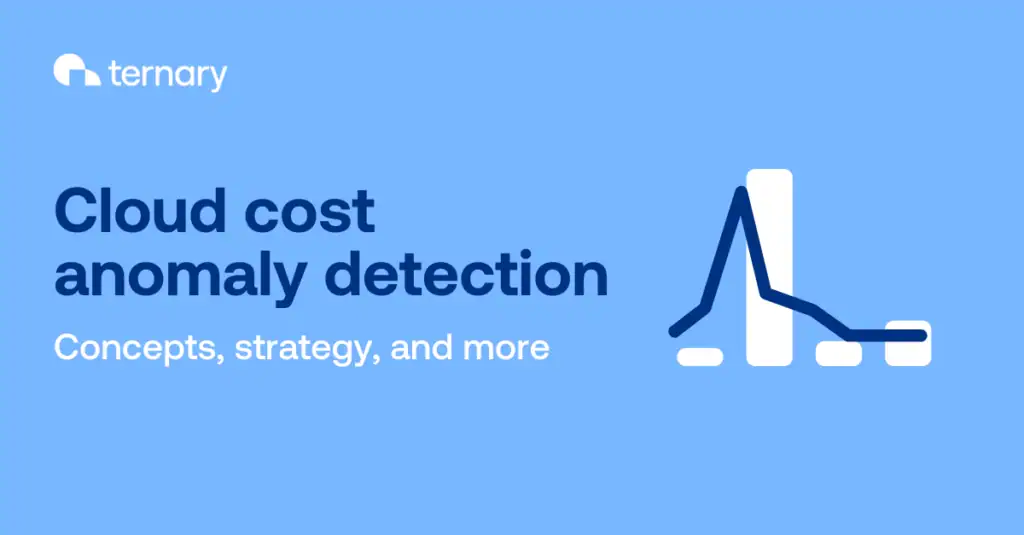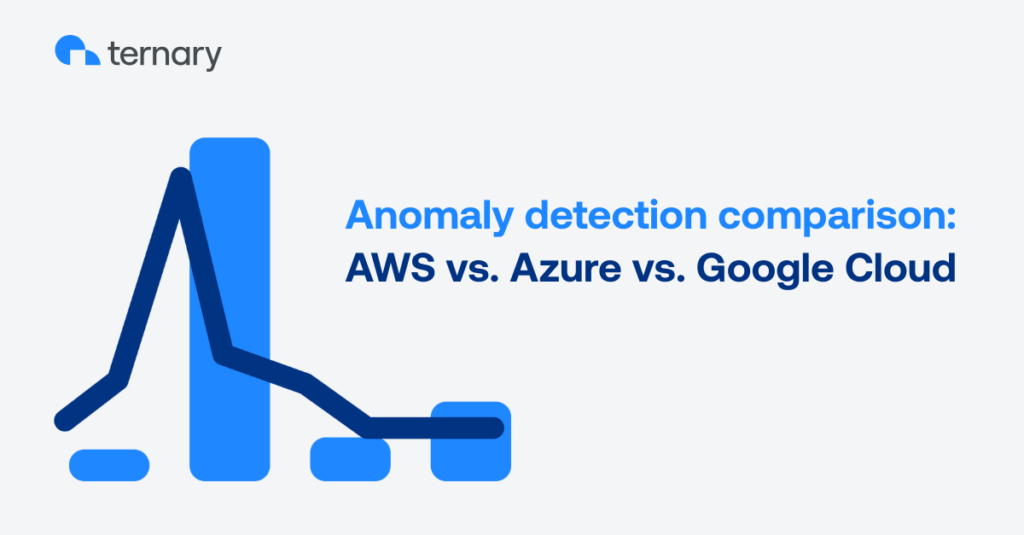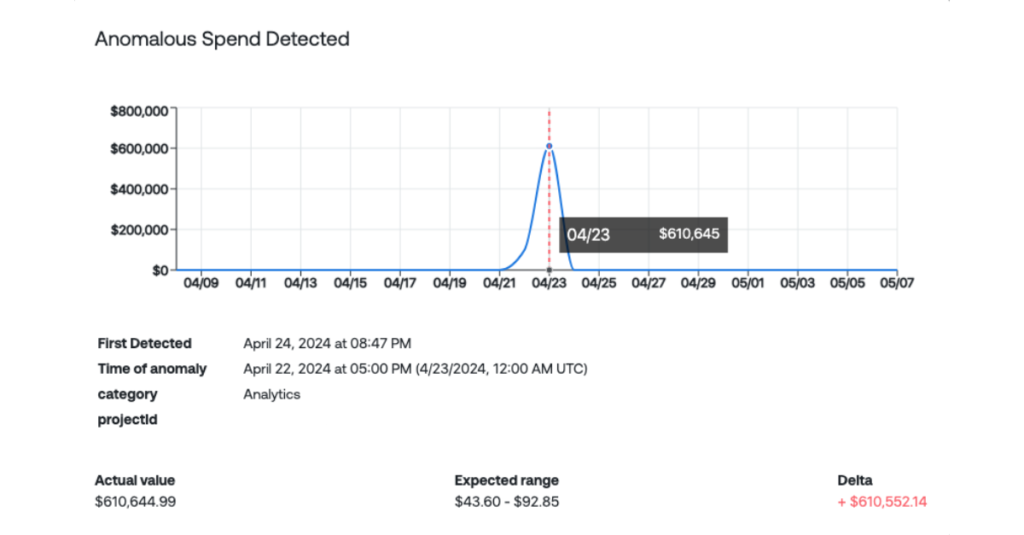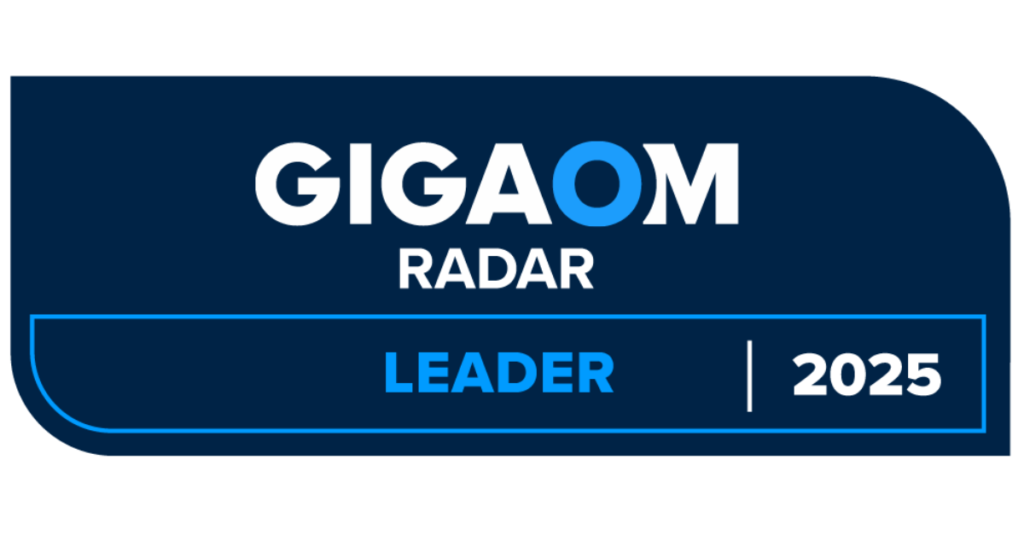Cloud bills have a silent way of ballooning overnight. You wake up to a cost spike from a mystery workload, and suddenly, you’re investigating like it’s CSI: AWS.
In large, fast-moving cloud environments, catching these anomalies before they burn through your budget is both an art and a science. That’s why we’ve created this guide on cloud cost anomaly detection to help you stay one step ahead of unexpected spend before it shows up on your next invoice.
Let’s start.
Cloud cost anomaly definition
According to the FinOps Foundation, “Anomalies in the context of FinOps are unpredicted variations (resulting in increases) in cloud spending that are larger than would be expected given historical spending patterns.”
Not every weird number on your bill is a red alert. A little spending fluctuation can be normal. But when something leaps off the chart compared to past usage trends? That’s when we have found an anomaly.
Now, what qualifies as an anomaly totally depends on your cloud cost model. A startup’s idea of “unexpected” might be a rounding error to an enterprise.
But what causes these anomalies? Anomalies can sneak in through:
- Misconfigurations
- Idle resources
- Rogue deployments
The problem is that even small glitches, if left unchecked, start snowballing.
Technical foundation of cost anomaly detection
From a technical lens, anomaly detection works in layers.
- First, the data collection layer grabs everything: usage logs, cost metrics, all piped in through APIs from cloud providers.
- Then comes the analysis layer, where machine learning models are run and compare current behavior against historical trends.
- Finally, the response layer kicks in (alerts, auto-shutdowns, resource throttling), whatever it takes to contain the budget fire.
Types of cloud cost anomalies
Let’s explore what kinds of cloud cost anomalies you’re most likely to run into:
- Usage-driven cost spikes. These show up when your cloud bill jumps thanks to actual usage changes. These changes can be from sudden user growth, autoscaling, or a surprise deployment that nobody mentioned on Slack.
- Drop in unit economics. If your cost per unit of revenue suddenly worsens, that’s a red flag. Maybe your compute cost stayed the same, but you’re making less from it. That’s a clue your cloud cost model needs tightening.
- Cost per usage spikes. Sometimes your usage doesn’t change, but your cost per unit does. It might be a switch from reserved to on-demand instances, or someone swapped to pricier resources without telling finance.
- Configuration issues. Misconfigurations like oversized test environments or forgotten dev virtual machines keep bleeding money quietly. While this is easy to overlook, it can be expensive to ignore.
- External pricing fluctuations. Sometimes it’s not you, it’s them. Currency changes, third-party service fees, or surprise cost adjustments from your cloud provider can all trigger anomalies.
Importance of anomaly management
Cloud cost anomaly detection prevents long-term financial instability. This is because anomalies can hint at:
- Deeper infrastructure issues
- Bugs
- Security breaches
- Inefficiencies
Actively monitoring and managing anomalies helps organizations avoid relying on guestimates. This vigilance also helps keep their forecasts, budgets, and overall cloud cost model aligned.
If an anomaly goes undetected, it skews cost predictions and undermines the algorithms used for future financial planning. Worse, it can impact system performance or reliability if the root cause affects resource availability.
Continuous, real-time anomaly detection feeds more accurate forecasting, which keeps surprises out of your budget review meetings.
Lifecycle of a cloud cost anomaly
Once a cloud cost anomaly is detected, it enters a structured lifecycle. Here’s how that typically unfolds:
- Record creation. Every detected anomaly should be logged with relevant metadata: what service it affected, how severe the impact was, and how wide its scope reached. This creates a reference point for analysis and pattern tracking.
- Notification. Based on the criticality, alerts can be routed through appropriate channels. High-severity anomalies might trigger instant messages or app alerts. Lower-priority ones can be queued for periodic review. Your goal is to avoid alert fatigue while keeping stakeholders informed.
- Analysis. This stage digs into the “why” of the anomaly. Is the cost surge due to intended activity, like a new deployment? Or was it unexpected, possibly a misconfiguration or spike in demand? Context matters, and understanding intent is key before taking any corrective steps.
- Resolution. Once the root cause is identified, teams decide on an action plan. That could mean:
- Terminating idle resources
- Reconfiguring services
- Updating internal deployment policies
- Retrospective. After resolution, the data should be fed back into the system. This step helps improve:
- The anomaly detection dashboard
- Enhances KPIs (like cost avoided)
- Strengthens the feedback loop so similar anomalies can be caught earlier or avoided altogether

Measuring cloud cost anomalies
Cloud cost anomaly detection starts with three core metrics:
- Time to detection (how fast you discover it)
- Time to root cause (how long the investigation takes)
- Time to resolution (how long before it’s actually fixed)
These timelines expose operational bottlenecks. From there, the KPIs tell the broader story. You want to track and measure:
- The number of anomalies
- Their associated anomalous cost
- How quickly the anomaly detection dashboard responds
- How much cost you avoid
- How many alerts were real vs false
- And how long each phase takes (detection, notification, analysis, resolution)
Other terms and definitions to know
Severity
Severity refers to the impact level of a cloud anomaly. It can start as a minor hiccup (low) and morph into a billing nightmare (critical) if left unchecked. Giving business users control over setting what qualifies as “critical” keeps alert fatigue at bay and attention on the wallet-draining stuff.
Timescale
Unlike budgets that move at the majestic pace of months or quarters, anomaly detection works best on a daily basis, sometimes even hourly. That way, you catch anomalies in their sneaky early stages before they turn into budgetary nightmares.
Challenges involved with identifying and resolving anomalies
Cloud anomaly detection comes with real operational friction. Here’s what teams face:
- Signal-to-noise ratio: In dynamic environments, real anomalies often look like normal activity. Without a system tuned for pattern recognition, teams drown in false positives or worse, ignore valid alerts.
- False positives and prioritization: If everything is an “urgent” alert, nothing actually is. Misclassifying severity wastes time and causes burnout. Tagging anomalies by priority (low, medium, high, critical) helps focus resources where they matter.
- Latency: Billing data lags. Anomalies might be halfway done before anyone sees a dashboard notification. This delay can mean hours or days of uncontrolled cloud cost increases.
- Scope and aggregation complexity: In large or multi-cloud organizations, mapping an anomaly back to its business context is tricky. You need to align anomalies with organizational units, cloud accounts, and service tags to detect what actually matters to your cost model.
Anomaly detection examples across FinOps maturity levels
The FinOps Foundation Working Group has thoroughly documented examples of the anomaly lifecycle across various maturity levels. Their examples have been summarized into the following table:
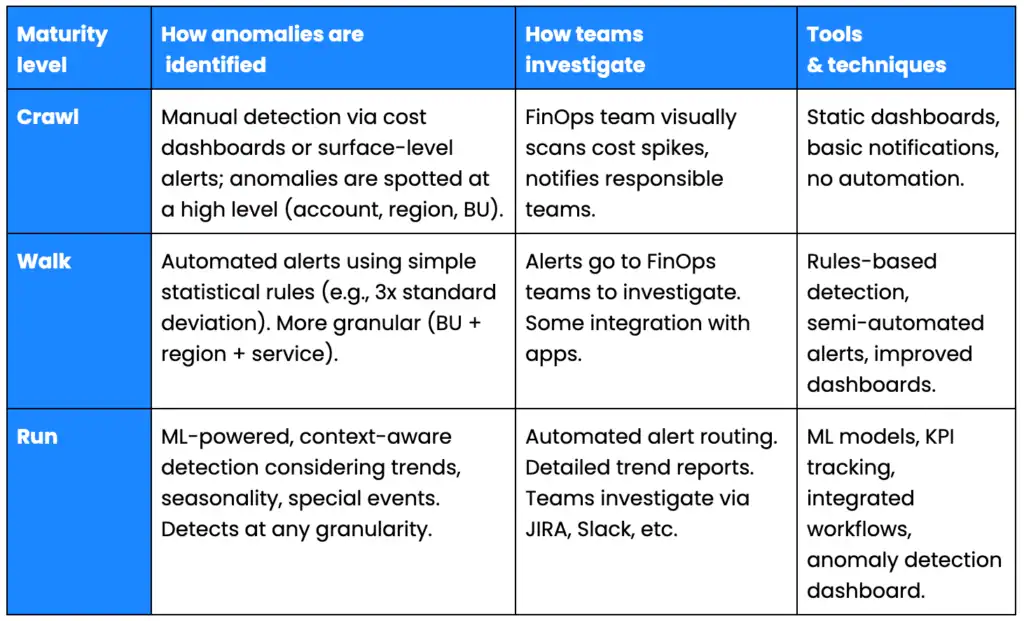
The responsibilities of key FinOps personas
Each core FinOps persona has a role to play when it comes to anomaly detection.
- FinOps Practitioners manage the anomaly lifecycle (detection → resolution → retrospection), ensuring cross-team accountability.
- Product Owners collaborate with Engineering on root cause analysis and corrective actions.
- Engineering implements fixes, optimizes resources, and provides technical insights.
- Finance adjusts forecasts, tracks cost deviations, and ensures financial alignment.
- Leadership oversees anomaly management efficacy via KPIs and strategic alignment.
View the Managing Cloud Cost Anomalies article by the FinOps Foundation for a full RACI.
Anomaly detection with Ternary
Cloud cost anomaly detection shouldn’t be optional (and we mean it). Yet, most tools today treat it exactly like that. They offer only cookie-cutter rules with no room to fine-tune or filter.
Ternary flips that script. Our machine learning-powered engine flags anomalies along with letting you investigate them through a lens you control.
Plus, our case management feature makes it ridiculously easy for teams to collaborate, investigate, and resolve issues before they spiral.
Step by step
Here’s how cloud cost anomaly detection works in Ternary:
1. Create an alert
Start by creating customizable alert rules based on absolute or percentage thresholds to monitor increases or decreases in cloud spending patterns over time. Optionally bypass the AI/ML algorithms to configure prescriptive threshold alerting rules.
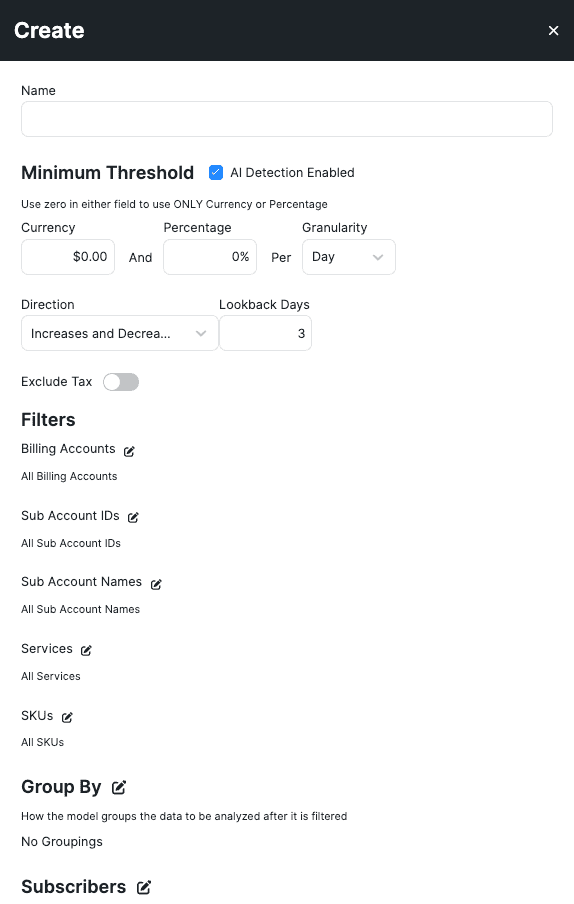
2. View recently triggered alerts
Your five most recent alerts show up in a dynamic list in the anomaly dashboard. Each anomaly includes a status tag (active, investigating, unresolved, or resolved) to help prioritize which anomalies still need attention.
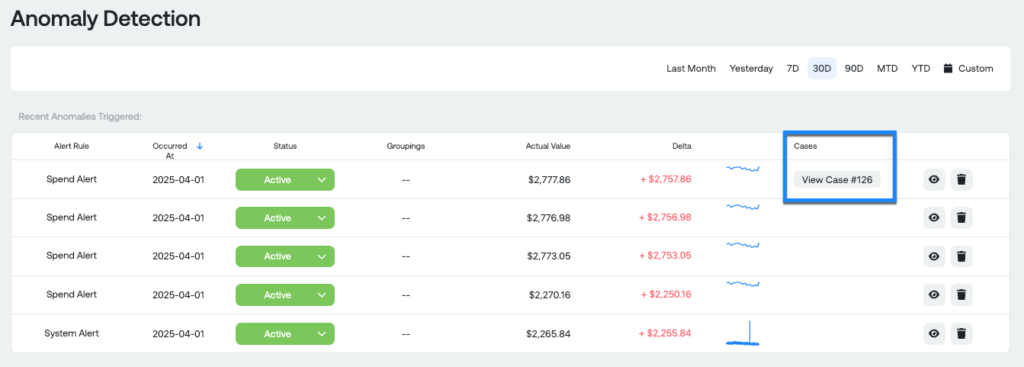
3. Deep dive into alert details
Click the eye icon for a detailed breakdown. You’ll see:
- When it was detected
- What the actual vs. expected cost range was
- The delta that triggered the alert
This is your high-level anomaly snapshot.

4. Investigate the anomaly
Hit “Identify Root Cause” to investigate the source of the anomaly.
You’ll be taken to a filtered report aligned with the anomaly’s timestamp. Use filters and groupings to isolate the cost driver. Visualizations (charts and tables) make the spend story crystal clear, complete with anomaly markers and cost-by-resource breakdowns to help investigate the source of anomaly.
Additionally, you can create a case for tracking the investigation. You can also take action by optionally linking the case to Jira. That way, you and your engineering teams can easily collaborate and analyze any data points you find in your cloud bill.
Learn more about Ternary Anomaly Detection in our documentation article.
Future developments: emerging technologies
Predictive analytics is becoming a key player in helping teams forecast cloud costs before they spiral. On top of that, automated root cause analysis is evolving, so you get insights about the why of an alert.
Add to this the growing power of API integrations, seamless compatibility across platforms, and standardized reporting, and you’ve got a future where cloud anomalies are spotted, explained, and resolved faster than ever.
Want high-accuracy cloud anomaly detection? See what Ternary can do for your team.

